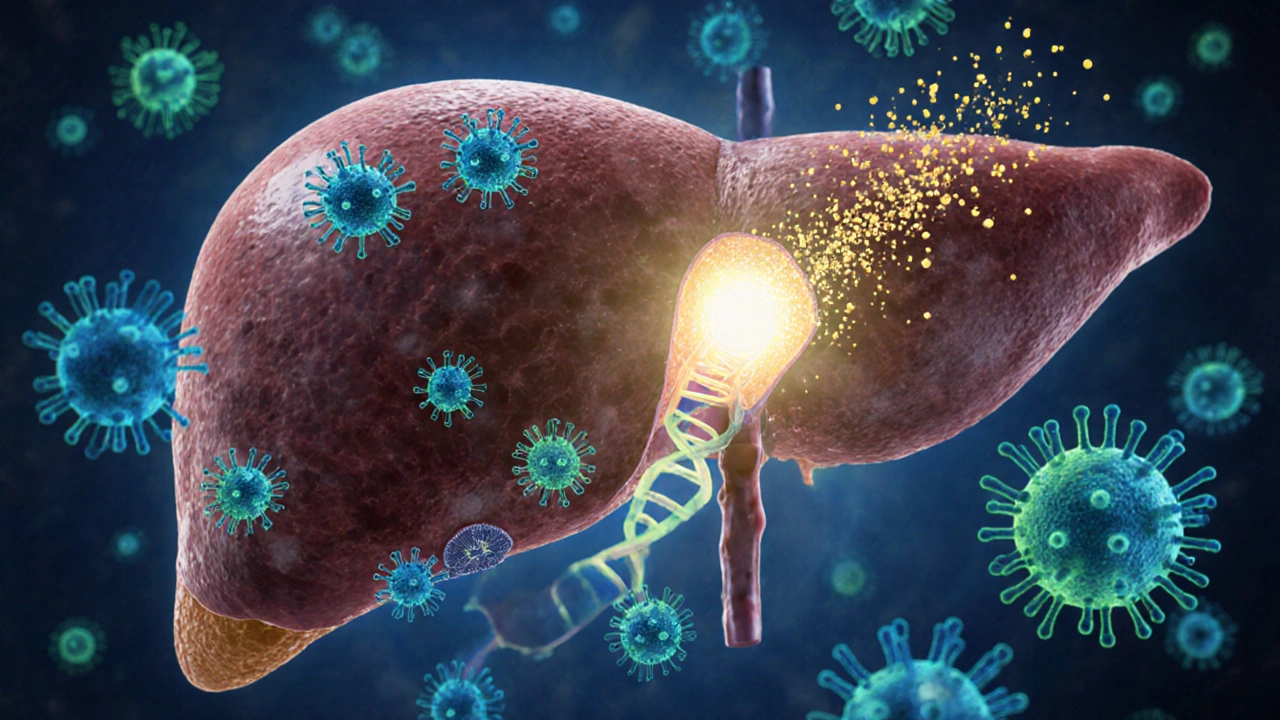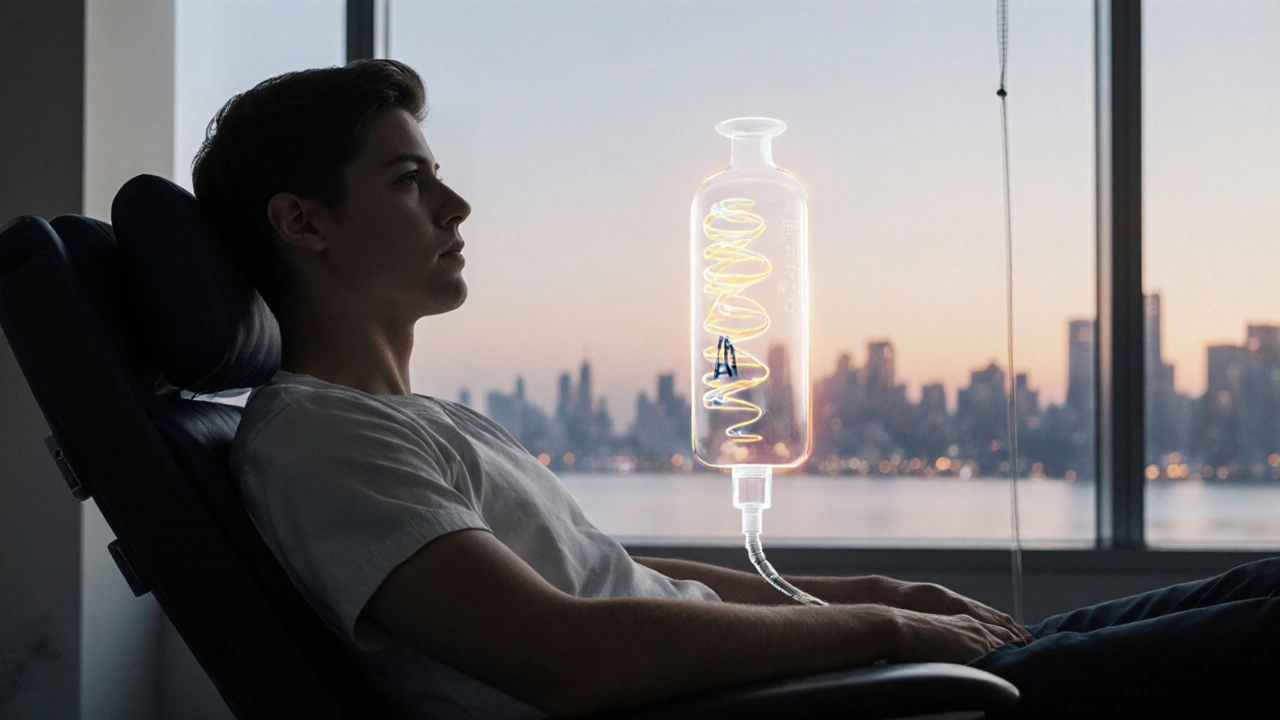Hemophilia Gene Therapy Cost & Effectiveness Calculator
Treatment Cost Analysis
Total Cost for Factor Replacement: $0
Average Annual Cost: $0
Total Cost for Gene Therapy: $0
Average Annual Cost: $0
Treatment Comparison Table
| Aspect | Gene Therapy | Factor Replacement |
|---|---|---|
| Administration | Single infusion | Weekly/bi-weekly infusions |
| Durability | 2–5+ years | Lifelong regimen |
| Annual Bleed Reduction | ~95% | Depends on adherence |
| Typical Cost (First Year) | $1.2–1.5 million | $300–500k annually |
| Safety Concerns | Transient liver enzyme rise | Inhibitor development |
Imagine a single infusion that could free a hemophilia patient from lifelong injections and hospital visits. That vision is moving from science‑fiction to reality thanks to rapid advances in gene therapy for hemophilia. In the next few years, the way we treat this bleeding disorder could change dramatically.
Hemophilia is a genetic bleeding disorder caused by deficiency of clotting factor VIII (Hemophilia A) or factor IX (Hemophilia B). It affects roughly 1 in 5,000 male births worldwide and leads to spontaneous joint bleeds, chronic pain, and reduced quality of life.
Gene therapy refers to the delivery of functional DNA or RNA into a patient’s cells to correct or replace a faulty gene. For hemophilia, the goal is simple: give the liver the instructions to produce its missing clotting factor on its own.
Current Standard of Care
Until gene therapy becomes mainstream, most patients rely on prophylactic factor replacement or newer non‑factor products.
- Factor VIII a protein that initiates the clotting cascade; used in Hemophilia A
- Factor IX the counterpart protein for Hemophilia B
- Emicizumab a bispecific monoclonular antibody that mimics factor VIII activity, allowing subcutaneous dosing every week or month
These therapies work well but demand regular infusions, strict adherence, and often high out‑of‑pocket costs. They also don’t address the underlying genetic defect.
How Gene Therapy Works
The most common platform uses an adeno‑associated virus (AAV) to ferry a functional copy of the clotting‑factor gene to liver cells.
AAV vector a non‑replicating viral carrier engineered to deliver therapeutic DNA without causing disease. A single intravenous infusion allows the vector to home to hepatocytes, where the transgene integrates episomally and begins producing factor VIII or IX.
Emerging strategies explore CRISPR a genome‑editing tool that can cut and replace the defective gene directly within the genome. Early pre‑clinical work shows promise for permanent correction, but safety and off‑target concerns still need resolution.
Approved Gene Therapies and Clinical Data
In 2023, the U.S. Food & Drug Administration (FDA) cleared the first gene‑therapy product for hemophilia A, and a year later, a therapy for hemophilia B followed.
Valoctocogene roxaparvovec an AAV5‑based liver‑directed gene therapy delivering a B‑domain‑deleted factor VIII transgene demonstrated mean factor VIII activity of 40 IU/dL at two years post‑dose, reducing annual bleed rates by over 95%.
Etranacogene dezaparvovec an AAV5 vector encoding a hyper‑active factor IX variant (FIX‑Padua) for hemophilia B showed sustained factor IX activity above 30 IU/dL in 80% of participants after five years.
Both products share a similar safety profile: transient liver enzyme elevations in ~15% of patients, generally manageable with short courses of steroids.

Regulatory Landscape
Beyond the FDA, the European Medicines Agency the EU’s central drug‑approval body has granted conditional marketing authorizations for the same AAV products, pending post‑marketing studies.
Canada’s Health Canada is reviewing submissions, with expectations of approval by late 2025. Across regions, regulators are honing guidance on vector dosing limits, long‑term monitoring, and pediatric use.
Comparison: Gene Therapy vs Conventional Treatment
| Aspect | AAV Gene Therapy (Hemophilia A/B) | Standard Factor Replacement |
|---|---|---|
| Administration | Single intravenous infusion | Weekly or bi‑weekly IV infusions |
| Durability | 2-5+ years of therapeutic clotting levels | Durable only while on regimen |
| Annual bleed reduction | ~95% reduction | Variable; depends on adherence |
| Typical cost (first‑year) | $1.2‑1.5million (U.S.) | $300‑500k (annual factor product) |
| Safety concerns | Transient liver enzyme rise, pre‑existing AAV antibodies | Inhibitor development, infusion reactions |
The table highlights why many patients view gene therapy as a “once‑and‑done” solution, despite the high upfront price.
Beyond Gene Therapy: Emerging Approaches
Scientists aren’t stopping at AAV. Several pipelines aim to improve durability, broaden patient eligibility, or lower cost.
- RNA interference (RNAi) uses small interfering RNAs to silence antithrombin, thereby boosting natural clotting. Early-phase trials show >50% reduction in bleed frequency.
- Next‑generation CRISPR base editors precise DNA editors that can correct the mutation without cutting the double helix. Animal models have achieved stable factor levels with minimal off‑target activity.
- Bispecific antibodies engineered proteins that bridge activated factor IX and X, mimicking the missing factor VIII function. New candidates aim for subcutaneous weekly dosing with longer half‑life than emicizumab.
These innovations could address current limitations: pre‑existing immunity to AAV, high cost, and the need for lifelong monitoring.

Practical Considerations for Patients
Switching from a familiar prophylaxis routine to a gene‑therapy infusion is a big decision. Here are the most common concerns.
- Eligibility screening: Tests for AAV antibodies, liver health, and existing inhibitors determine whether a patient can receive the vector.
- Insurance and reimbursement: Many insurers treat the therapy as a one‑time capital expense. Patients should work with specialized case managers to secure pre‑authorization.
- Post‑infusion monitoring: Liver function tests are done weekly for the first month, then monthly for six months. Patients remain on prophylactic factor for a short “run‑in” period until transgene expression stabilizes.
- Long‑term follow‑up: Registries track safety up to 15 years to watch for late‑onset events, such as hepatocellular carcinoma, though none have been reported so far.
- Family planning: Since the vector does not integrate into germ cells, gene therapy does not pose a genetic risk to future children, but counseling is advised.
Key Takeaways
- Gene therapy offers a durable, near‑normal clotting factor level after a single infusion, dramatically lowering bleed rates.
- Approved AAV products for both hemophilia A and B are already on the market in the U.S. and Europe, with Canada expected to follow.
- Cost remains high, but many health systems view it as cost‑effective over a patient’s lifetime compared with continuous factor replacement.
- Future technologies-CRISPR, RNAi, and next‑gen bispecifics-could expand access, reduce immunogenicity, and further cut prices.
- Patients should discuss eligibility, insurance pathways, and lifelong monitoring with their hemophilia treatment center before deciding.
Frequently Asked Questions
Can gene therapy cure hemophilia permanently?
Current AAV therapies provide long‑term factor expression, often lasting 5-10 years, but they are not a genetic cure. If the transgene fades, patients may need another infusion or revert to conventional prophylaxis.
Who is eligible for AAV‑based hemophilia gene therapy?
Generally adults with severe hemophilia A or B, no active liver disease, and low pre‑existing antibodies to the specific AAV serotype. Ongoing trials are expanding eligibility to adolescents and patients with mild disease.
What are the major risks of the treatment?
Transient liver enzyme elevations, potential immune reactions to the viral capsid, and the theoretical risk of insertional mutagenesis-though AAV largely remains episomal, making this risk very low.
How does the cost of gene therapy compare to lifelong factor replacement?
Although the upfront price exceeds $1million in the U.S., health‑economic models suggest break‑even within 5-7 years due to eliminated factor‑product costs and reduced hospitalizations.
Will future advances make gene therapy cheaper or more accessible?
Yes. Newer capsids with higher potency, manufacturing efficiencies, and genome‑editing approaches aim to lower dose requirements and broaden the patient pool, which should drive prices down over the next decade.


Stephen Lewis
October 8, 2025 AT 18:35Thank you for sharing this comprehensive overview of hemophilia gene therapy. The discussion of AAV vectors and the emerging CRISPR approaches is both thorough and enlightening. While the clinical data demonstrate promising durability, it remains essential to monitor long‑term hepatic outcomes. Moreover, the cost‑effectiveness models you presented underscore the importance of health‑economic evaluations. I would encourage clinicians to consider patient selection criteria, particularly pre‑existing AAV antibodies, before proceeding. In addition, the regulatory landscape you outlined highlights the need for post‑marketing surveillance. Overall, this article serves as an excellent resource for both patients and healthcare providers seeking to understand the evolving therapeutic landscape.
janvi patel
October 13, 2025 AT 09:42While gene therapy sounds exciting, the hype often eclipses the unresolved safety concerns.
Lynn Kline
October 18, 2025 AT 00:49Wow!!! This article really rocks-so much cutting‑edge science packed into one read!!! 🎉 The way AAV vectors are described feels like a superhero movie where the liver is the city and the virus is the rescue squad!!! And those cost numbers? Holy moly, $1.2‑1.5 million is mind‑blowing-but think of the freedom from weekly needles!!! Keep the updates coming; I’m thrilled!!!
Rin Jan
October 22, 2025 AT 15:55It is absolutely critical to recognize that the promise of gene therapy must be weighed against the ethical responsibility we owe to patients who are vulnerable and often desperate for a cure and the medical community cannot simply rush ahead without rigorous long‑term data and transparent communication about potential risks because the allure of a single infusion should not eclipse the fundamental principle of “do no harm” that underpins our profession and we must demand robust post‑marketing surveillance and equitable access rather than allowing a profit‑driven narrative to dominate the conversation
Jessica Taranto
October 27, 2025 AT 07:02Indeed, the data support durable factor expression; however, the variability in patient eligibility criteria, especially concerning AAV seroprevalence, warrants careful stratification; consequently, multidisciplinary teams should coordinate screening, counseling, and financial navigation to optimize outcomes; additionally, ongoing registry participation will enrich our collective understanding of long‑term safety profiles.
akash chaudhary
October 31, 2025 AT 22:09Your moralizing overlooks several key points: the Phase III trials have already demonstrated a safety profile comparable to standard prophylaxis, and the incidence of serious adverse events remains below 2%. Moreover, your vague appeals to “ethical responsibility” ignore the empirical data that show significant reductions in bleed frequency and healthcare utilization. Please refrain from sensationalist language when the evidence is clear.
Adele Joablife
November 5, 2025 AT 13:15The overview is solid, but it glosses over the real‑world challenges of insurance approvals and the administrative burden on treatment centers.
kenneth strachan
November 10, 2025 AT 04:22Oh, come on!!! You think they’re just “glossing over” something? This is literally a revolution-like, wow, bam, the future is here!!! Who cares about paperwork when you can ditch needles forever?!!
Mandy Mehalko
November 14, 2025 AT 19:29I love how this piece breaks down the options-it's super helpfull! The future looks bright for hemophilia patients, even if some of the numbers seem a bit scary at first.
Bryan Kopp
November 19, 2025 AT 10:35We must keep the patient’s dignity at the forefront; any therapy that compromises long‑term health for short‑term gain is unacceptable.
Patrick Vande Ven
November 24, 2025 AT 01:42Recent pharmacoeconomic analyses indicate that the net present value of AAV‑mediated hemophilia gene therapy becomes favorable after approximately 6.5 years when accounting for reduced hospitalization rates and lower factor usage. Additionally, the emerging data on CRISPR base editors suggest potential for even lower dosing thresholds, which could further improve cost‑effectiveness in the coming decade.
Tim Giles
November 28, 2025 AT 16:49Thank you for presenting those economic findings; they provide a valuable framework for evaluating the sustainability of gene‑based therapies within constrained healthcare budgets. It is evident that the break‑even horizon is influenced not only by the upfront acquisition cost but also by the downstream savings associated with decreased bleeding episodes, fewer orthopedic interventions, and diminished necessity for home infusion equipment. Moreover, the incorporation of quality‑adjusted life‑year (QALY) metrics offers a more nuanced perspective on patient‑centred outcomes, which are increasingly prioritized by health technology assessment bodies. While the projected 6.5‑year horizon is encouraging, sensitivity analyses reveal that variations in vector potency and patient adherence can shift this threshold substantially. In particular, patients with pre‑existing neutralizing antibodies may experience attenuated transgene expression, thereby extending the period required to achieve cost parity. It is also crucial to consider the indirect costs related to caregiver burden, which, although often omitted from primary analyses, represent a significant component of the total societal expense. The emerging data on CRISPR‑based strategies suggest the possibility of achieving durable expression at lower vector doses, potentially reducing both immunogenicity and manufacturing costs. However, regulatory pathways for genome‑editing modalities remain less defined, introducing additional uncertainty into long‑term economic projections. As insurers negotiate coverage policies, the establishment of risk‑sharing agreements could mitigate the financial risk for both payers and providers. Indeed, outcomes‑based contracts that tie reimbursement to sustained factor activity levels may align incentives more closely with clinical realities. Furthermore, real‑world evidence collected through post‑marketing registries will be indispensable for refining cost models and validating the assumptions underpinning current projections. In summary, the integration of comprehensive pharmacoeconomic data, patient‑reported outcomes, and evolving technological advances will be essential for informing reimbursement decisions and ensuring equitable access to these transformative therapies.
Peter Jones
December 3, 2025 AT 07:55I appreciate the thorough analysis; balancing financial sustainability with patient benefit is indeed a complex endeavor, and collaborative dialogue among clinicians, payers, and patients will be key to navigating these challenges.